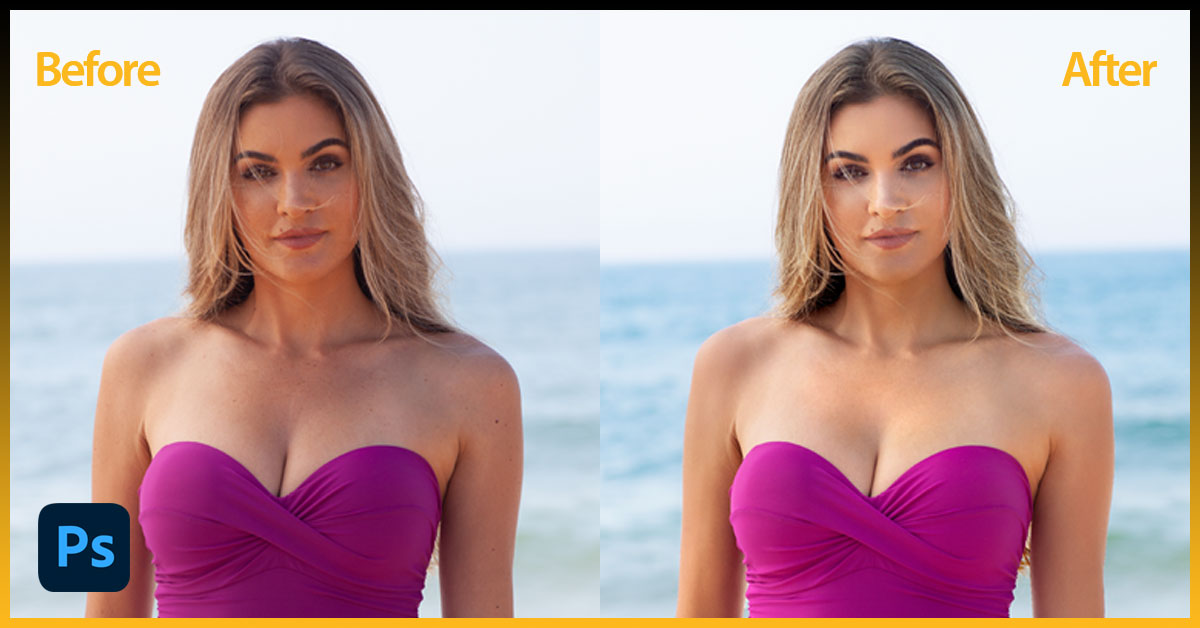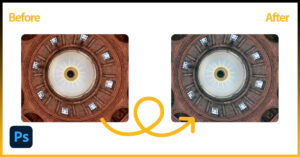Are you editing a photo in Photoshop and is it feeling like the colors just looked off? It may be that some colors are too yellow or have an unexpected blue tint.
Don’t worry! This is a common problem for many photo editors especially when you’re at the beginner level. All the problems have one solution – Color correction in Photoshop.
Here are the quick color correction tips in Photoshop for beginners from my hands-on experience:
- Use Photoshop auto color tools like “Curve or Level” to precise control over the highlights, shadows, and midtones of the image.
- Use color balance to fine-tune specific color casts.
- Hue saturation is great for adjusting the color intensity
- Or, use a gradient tool to create gradients between multiple colors.
Don’t end up here! Keep on reading to explore many more color correction tips to achieve natural-looking, beautiful colors in your Photoshop, even as a beginner.
What is Photo Color Correction?
In its simplest form, photo color correction refers to the process of adjusting the color of the image to achieve the desired look.
It is done to get the best color sense in one specific part of the image where the color has not come out well or to correct the issues with the original image.
Generally, the process involves changing the color balance, correcting the color casts, adjusting the contrast or brightness, and so on.
Photo color correction is an important part of photo editing, especially when you are a professional photographer and want to get an image that resembles real life.
Why is Color Correction Important in Photography?
Photo color correction is a highly important part of photography as it helps to improve the overall look of the image. It can fix any color issues that may occur in the shooting process, and offer a more consistent look.
You know, the importance of color correction in photography is vast and impressive. However, here let me discuss some of the most prominent ones.
1. Accuracy and consistency
To me for getting the accuracy and consistency after clicking the image, photo color correction plays a crucial role. Through this process, I can ensure the color matches the true colors of the subject and make it more realistic.
Moreover, it helps to maintain a consistent color palette throughout the project or the photo.
2. Positive impression
As a professional photographer, I believe it is one of the most crucial parts of color correction.
You know you can have a positive impression on your clients with the support of color correction. When your clients see your enhanced and impressive images, they can feel a sense of urgency to get your service. Here the color correction does it, leaving a positive impression on whoever sees it.
3. Smooth promotion
At the same time by leaving a positive impression on your clients, you can promote your service smoothly. Color correction will enhance or change the overall look of your images and you can use that for promotional purposes.
4. Boosting sales
If you are using photography for your business purposes, of course, you must ensure that your product images look attractive to grab the audience’s attention right away.
That’s because the clients see images even before they check the products in real. Here the color correction will help you to make the images vivid and gain success in business.
How to Color Correct Photos In Photoshop? [Step-by-step Tutorials!]
Photoshop offers several effective techniques starting from basic to professional to transform any photo from dull to dazzling. Let me start with a quick color adjustment tool in Photoshop- the Color Balance tool.
It’s a fantastic way to target unwanted color casts and bring out the natural beauty in my photos.
Step -1: Open Photos In Photoshop
All you need to start by arranging the workspace in your Photoshop. Select the photo that you want to color correct and upload it in the Photoshop workspace. It is quite easy to do so.
Go to File > Open and add the image from your device to Photoshop. You can drag and drop it manually or use the key shortcut ctrl+O.
Step -2: Create A Duplicate Layer
Now before heading to color correct your selected image, make sure Photoshop settings are at default.
You will have to create a duplicate layer for your image background. To do this, go to “Layer Panel” and then click on the right-side Menu option.
Select “Duplicate Layer” from the appeared option and a dialogue box will appear. Rename it and click ok.
As a shortcut key, click “Command+J” from Mac or “CTRL+J” to create a layer in Windows.
Step -3: Use The Color Balance Tool
If you are thinking about a basic and automatic color correcting tool, I would definitely suggest the Color Balance.
It is the most convenient color editing tool which works with a few complementary colors including magenta and green, cyan and red, yellow and blue. Editors find this tool most effective to fix the white balance in Photoshop.
Anyway, to use this tool,
Go to the Layer Panel and click on the Adjustment Layer menu (Right beside the Layer mask icon). Select the color Balance from the appeared options.
Now depending on the color condition of your image, adjust it by increasing or decreasing the slider.
For example, if your image has more redness, drag the slider to the left. Again, if it looks a bit yellow, go to the Yellow/Blue slider and drag it to the right side.
Step -4: Adjust The Curve & Level Line
After color-correcting your photo, you can make it pop up using the curve and level line. The tools mainly fix the exposure of your photo and make your image subject brighten up.
Even you can adjust the highlights, midtones, and shadows of your image through this tool.
To access the tool, go to Layer>New Adjustment Layer and then select the Curve and Level of the photo. Simply drag the slider up or down and adjust the light and contrast of your image as you need.
Step -5: Save The File
Well when you have all done with the color correction of your image, this is the time to save the file. Go to file, and then select Save As and save the image.
Alternative Tools For Color Correction In Photoshop
Besides the color balance, you will find a good range of color correction tools in Photoshop to help you improve the overall image quality and make it visually appealing and accurate.
Let me introduce 2 more effective and quick workable color-correcting tools in Photoshop which I frequently use.
Hue And Saturation
Hue and Saturation is a very useful tool in Photoshop for correcting the color of an image. Hue mainly refers to the actual color itself, like red, green, or blue. It equips a slider which you can use to shift the colors in your image around a color wheel.
Coming back to the saturation, it mainly controls the intensity of the color.
Dragging the Saturation slider right makes the colors more vibrant while dragging left makes them more muted.
While quickly editing a photo when I was in a hurry, these tools have proved effective enough to me in making a dull image more colorful or a very saturated image more toned down.
Gradient Tool
The gradient tool is another effective tool in Photoshop that makes gradual changes in the color and light of an image with precision.
I mostly use this tool to seamlessly blend the color and transparency in images and fix the affected parts. You can even remove, add, or rearrange the color of your desired image. You can use the gradient tool in many ways including-
- Linear,
- Radial,
- Angle,
- Reflected,
- Or Diamond.
Though it is a bit tricky to use these tools in images, let me share the best and quickest tips to master the gradient tool:
Step -1: Select a shape in Photoshop
The first step would be selecting a shape in Photoshop using the shape tool from the toolbar. Then go to the Custom shape and choose a shape as your preference such as a square or rectangle tool.
Step -2: Fill The Gradient Shape
Now that you have selected a shape, go to the top bar menu and click on the right arrow from the Fill option. In the drop-down window, Click On the Gradient Tab.
Step -3: Open the Gradient Tool Settings
Go to the Layers panel on the right-hand side and double-click on the Layer thumbnail of your selected shape. A gradient settings box will pop up on the screen highlighting various settings of the gradient tool.
Step -4: Select The Gradient Type & Color
At this step, double-click on the Gradient and choose any of your favorite colors to use as a gradient color.
Click on the bottom handle and customize the color as your own. Then select the gradient type (radial, angle, reflected, and diamond) and click on the shape to apply the color. Click “OK” to save your changes.
If needed, use the gradient tool from the toolbar and draw a line to define the length and angle of the gradient.
Color Correcting Photos In Photoshop Using “Threshold” Adjustment Layer
When you want to change the color intensity of a certain level of an image, I recommend working with the Threshold adjustment layer.
This technique is quite useful when you want to work on the specific adjustment of an image based on brightness levels. Using this filter, you can control image color tones in Photoshop, making it turn black or white.
I mostly use this filter to clearly define the black-and-white areas in my image and give it a bold look. It helps me to work with other editing tools further.
Let me explain how you utilize this tool to color-correct your Photoshop image.
Step 1: With the image opened in Photoshop, create a new adjustment layer for your image background. Simply go to the “Layers Panel” and then go to the New Adjustment Layer. Now select the Threshold from the list of adjustment layers.
Step 2: Right after that, you will find a dialog box appearing on your screen. Use the slider and make your image darker or lighter as you want. Dragging the slider right will make the image totally black.
Step 3: Move it to the left to make the light colors visible as you want. These are the lightest parts of your image. Stop dragging when you find the lightest parts.
Step 4: Now select Color Sampler Tool from toolbar and start selecting lightest parts.
Step 5: When that happens, hold the “SHIFT” and turn the white area to take a color sample. Press the Option key if you use Mac in this instance.
Then click on any part of the white area to place a target marker at that location. You will find a small number 1 in the bottom right of your marker.
Step 6: Follow the same process for the black areas and make a color sample 2 for it.
Step -7: When done, now simply press the Cancel button in the top right corner of the dialog box and delete the Threshold adjustment layer.
Step 8: Now create a new adjustment layer in the layer panel and select “Levels” from the list.
Step 9: Once you find that, go to the Properties panel and click on the white point eyedropper. You will get your first target marker, so click on it.
Step 10: Same as before, select the black point eyedropper from the Properties panel and click the second target marker. This is how you can easily fix any color or tonal issues in the highlight and shadow areas of the image.
[If needed, you can temporarily hide the target markers by pressing Ctrl+H on Windows and Command+H on Mac.]
Adjusting Midtones
If you find your image a bit too dark after color correction, you can easily fix it by adjusting the midtones. For instance:
- Go to the Levels dialog box and find the Midtone slider. Drag it to the left to brighten the midtones. If needed, drag it to the right to make it darker.
- However, all depends on the condition of your image. Once you are done, click OK in the Levels dialog box to finalize your edits.
When you’ve finished your edits, you can completely remove the target markers. To do so:
- Click on the eyedropper icon from the tools panel and select the Color Sampler Tool.
- Go to the top option bar and press Clear All. That’s it! You’re done with everything!
Color Correction VS Color Grading- What’s The Difference?
As a beginner, it is quite obvious, you will get confused between the terms color correction and color grading. As a newcomer in this field, you may assume these two terms are the same- but they’re actually not!
Color correction is mainly the technical accuracy of any image. It refers to adjusting the color balance, white and black level, exposure, contrast, brightness, and white balance of an image at an accurate level.
All that process makes your photo colors look natural and realistic, as close to how they appeared in the real scene as possible.
Now coming to color grading, it is mainly a creative image editing process where you adjust color in a photo and make it in a stylized tone and mood.
To be short, it is needed after image color correction to enhance the mood, style, and storytelling of the image.
In color grade, you should have a clear goal and know what exactly you want to achieve through adjusting the tone of your image. But in color correction, the goal is to make the colors appear natural without any stylistic adjustments.
Best Photo Color Correction Services To Choose Online
Color correction requires specific skills and knowledge of color theory and color management to accurately adjust and balance the color of an image. Well, we have already discussed all the basic techniques to apply at the beginner level in this guide.
But in case you have a large number of images that need color correction, outsourcing can be life-savior for you. It will not only save you significant time and effort but also let you meet with consistent quality across all images.
However, here we have a comprehensive list of the best services for image color correction you can choose online:
1. Path Foto
If you are looking for a reliable photo editing service online to color correct your photo, Path Foto is the best one of them. It is an established outsourcing image editing company that has been serving clients globally for 10 years.
The best part is they specialize in providing manual, hand-drawn, which means not a single touch of AI in the service. You can even collaborate with a team of skilled image editors who will carefully review and resolve any issues manually, ensuring high-quality results.
Best Features
- 24/7 services, including weekends.
- Dedicated professional photo editor team.
- Focus on manual, high-quality work.
- Comprehensive customer support.
- Efficient turnaround times
2. Fotor
If you are looking for the best AI-powered image color correction service online, I would definitely recommend Fotor. It just simplifies the process of image color correction with the use of Ai-tool.
You need to upload your photo to their website and relax. The professionals of the Fotor will find out the color distraction of the image, fix those, and make all needed edits to bring the actual appearance of the image.
Best Features
- Brighten the image and bring out true colors.
- Fix the image color.
- Improve the image to a new level
- Delivers the edited image in HD format.
- Provides other editing services like resizing, formatting, adding photo effects, and so on.
3. Media.io
This is another free AI-powered color-correcting service you can choose online. With their enhanced photo color correction app, you can transfer any of the distracted images automatically and effortlessly.
Whether your image subject is looking overexposed or underexposed or lacks saturation, just upload your image here and see the magic here. Their superior AI tool will correct the colors of your image in a shorter span of time.
The best part, they offer the updated images in various file formats as per users’ demand while delivering, including high-quality JPG, JPEG, WebP, and PNG.
Best Feature
- Best customer service.
- Quick delivery.
- Unlimited revision.
- 100% quality retained.
- High-quality output with minimal loss.
FAQs
Which tools are great for fixing color distortion in Photoshop?
If you want to reduce image distortion, use color balance as a beginner. It allows you to target specific color casts in the image and neutralize it. Also, you can use Selective Color to adjust specific color ranges or Levels & Curves to fix the brightness and contrast of different tonal areas in your image.
How can the White Balance tool help correct an image’s color in Photoshop?
The White Balance tool is great for digital images to make it appear more realistic and natural to look at. You can easily adjust the color temperature toward cooler or warmer tones of your image with this tool.
Can I use the Color Lookup Tool in Photoshop to color-correct an image?
LUP or Color Lookup Tool in Photoshop is great for remapping the color and luminosity of an image. The table equips pre-made sets of color adjustments which you can apply in different areas in an image to give it a specific look or feel.
What is the easiest way to color-correct in Photoshop?
To quickly color correct in Photoshop, start by uploading an image in the workspace. Go to Image > Adjustments menu and pick any of the adjustment tools. Drag the slider and adjust the image color to your preference.
How to do basic color correction?
There are many color correction tools in Photoshop. As a beginner, you can start with the white balance for natural colors or correct the exposure and contrast for a pop or balance. To get vibrant colors, Hue and Saturation are right there for you.
What is the easiest way to replace a color in Photoshop?
The quickest way to replace a color in Photoshop is by using the Color Replacement tool through which you can change the existing color with any of your favorite colors. Go to Image> Adjustments> Replace Color and then select any color to replace.
How do you color in Photoshop for beginners?
Start by opening a file in Photoshop. Then unlock the background to make it editable. Now use the pen brush tool and fill the gaps. You can use the layer mask to isolate the background and then use the paintbrush and color picker tool to color your image subject as your own.
What are the color correcting techniques?
Color correction is all about changing or adjusting the color of an image. Use any of the color correction tools like Color Balance, Gradient tool, Hue and Saturation to color correct your image.
How do I learn color grading?
If you want to learn color grading, start with learning the basics on YouTube. Or, you can take an effective course from an online platform like Udemy or Skillshare on color grading as well. Then use digital software Adobe Photoshop or Lightroom to practice.
In Closing
While editing the photo in Photoshop, it’s not uncommon that you are not getting the exact color tone in your image that you ever want.
Maybe they were washed out and dull, or had a strange green tint? It happens to the best of us! But fear not, with our effective guide highlighting color correction tips in Photoshop for beginners, now you will be skilled in it-I bet!
We have discussed easy color correction tips to get you started. Kick off our tips and tricks for Photoshop color correction and achieve a more balanced and visually pleasing image.





